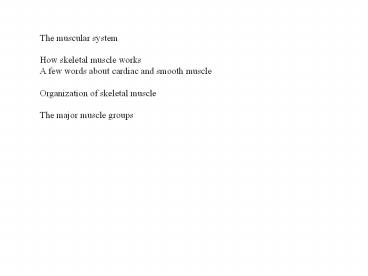The muscular system - PowerPoint PPT Presentation
1 / 16
Title:
The muscular system
Description:
The muscular system. How skeletal muscle works. A few words about cardiac and smooth muscle ... (note 'sarco' prefix) During muscle contraction these shorten ... – PowerPoint PPT presentation
Number of Views:11
Avg rating:3.0/5.0
Title: The muscular system
1
The muscular system How skeletal muscle works A
few words about cardiac and smooth
muscle Organization of skeletal muscle The
major muscle groups
2
(No Transcript)
3
The skeletal muscle cell the muscle fiber May
be as long as the muscle itself Several nuclei
and many mitochondria Extensive sarcoplasmic
reticulum Striations due to actin and myosin
filaments (myofibrils)
4
(No Transcript)
5
Sarcomere- functional unit (note sarco
prefix) During muscle contraction these
shorten Characteristic patterns seen I, A, H
bands, etc.
6
Neuromuscular junction
7
A motor unit
8
How does a muscle fiber contract? sliding
filament model Myosin filaments contain
cross-bridges pulling actin shortens
sarcomere Requirement for ATP and
calcium Action triggered by acetylcholine Stopped
by breakdown of the enzyme (see p. 178)
9
(No Transcript)
10
Sources for ATP? Respiration (aerobic and
anaerobic) anaerobic when oxygen runs
out pyruvate is converted to lactic
acid fatigue lactic acid is carried in blood to
liver, and converted back to glucose Creatine
phosphate Myoglobin Heat produced in process
helps sustain body temperature
11
Responses of single muscle fiber threshold
stimulus if this is achieved, muscle will
contract fully (all-or-none) Slow fibers- weak
contraction, resist fatigue contain more blood
flow,mitochondria aerobic exercise enhances
development Fast fibers- strong contraction,
fatigue easily anaerobic exercise will increase
number of filaments in a cell (not more cells)
12
A muscle fiber can be stimulated many
times (summation) so that it cannot relax
between twitches Tetany- sustained
contraction More than one motor unit can be
stimulated, too for sustained muscle
work Muscle tone- some contraction is sustained
13
Smooth muscle contains actin and
myosin filaments arranged differently
from skeletal muscle Regulated differently-
calmodulin Multiunit- separate fibers iris,
blood vessel walls Visceral (internal
organs) stimulus is transmitted from one
cell to another Rhythmicity- pattern of
contractions self-activated
14
Smooth muscle contraction controlled
by acetylcholine and norepinephrine Neurotransmi
tters stimulate different organs, have different
effects Smooth muscle fibers can sustain
longer contraction and use less ATP also can
stretch What sorts of movements are seen in
these organs?
15
Cardiac muscle striated, involuntary
muscle Cells are short and branched Calcium
channels regulate flux of calcium twitches last
longer than in skeletal muscles Intercalated
discs connect one cell to another help with
rapid transmission of signals
16
Entire structure (heart muscle) contracts as a
unit Is also self-stimulatory and
rhythmic Activity begins in a specific region of
the heart and spreads over the entire
structure Well talk about the pattern and
regulation later! Complarison of the 3 types of
muscle p. 185






























